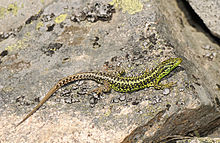Iberolacerta
| Iberolacerta | |
|---|---|
 |
|
| Iberolacerta monticola | |
| Scientific classification | |
| Kingdom: | Animalia |
| Phylum: | Chordata |
| Class: | Reptilia |
| Order: | Squamata |
| Family: | Lacertidae |
| Subfamily: | Lacertinae |
| Genus: |
Iberolacerta Arribas, 1999 |
| Species | |
|
8, see below. |
|
8, see below.
Iberolacerta is a genus of lizards in the family Lacertidae. The genus contains at least eight described species, which are mainly found in Spain and France. Iberolacerta horvathi (Horvath's rock lizard) has a wider geographic range, being distributed in Central Europe.
The species of Iberolacerta are distinct and mainly found in the western Europe mountain ranges.Iberolacerta species found in Germany could have possibly been caused by human introduction, and are thus controversial. For example, I. horvathi had been encountered in southern Germany, but has not been encountered thereafter.
This group of lizards contains widely distributed features such as: a depressed head and body; 7–9 premaxillary teeth; ~26 presacral vertebrae (for males); inscriptional ribs; tail brightly colored in hatchlings.
Some of the lizards in this genus contains specific features such as: rostral and frontonasal scales; one postanal scale; supranasal and anterior loreal scales; 36 or less macro chromosomes; egg-laid embryos somewhat developed.
Small species are up to ~85 mm long, but all species have shown to have females are larger than the male.
Speciation theory caused by mountain ranges and Pleistocene glacial cycles: It is believed that many of the Iberolacerta genus had led to many speciation seen today because of the Pleistocene glacial cycles and Holocene habitat fragmentation. For example, I. monticola has been studied to determine its cause of speciation. There was an analysis of 17 I. monticola population's mitochondrial DNA sequences, at a control region and cytochrome b loci, throughout the northwestern quadrant of the Iberian Peninsula. The results these researchers data gathered lead to the conclusion that correlated to a “refugia within refugia” model since the comparative phylogeographic analyses had shown consistent genetic subdivisions patterns. This suggested that the mountain ranges could potentially be the cause of the descending species of Iberolacerta. It was also hypothesized that the Holocene epoch then represented a long-term survival inflexion point for the derived species not to survive the preceding glacial cycle.
...
Wikipedia
